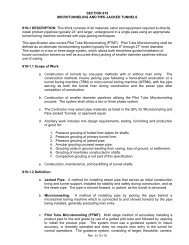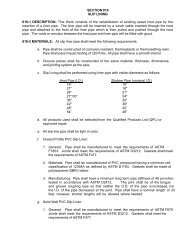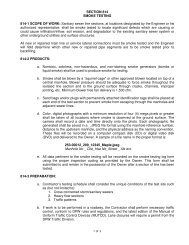Contents
Construction Management Plan - Baton Rouge Department of Public ...
Construction Management Plan - Baton Rouge Department of Public ...
- No tags were found...
Create successful ePaper yourself
Turn your PDF publications into a flip-book with our unique Google optimized e-Paper software.
• 0.5 ppm – 1 st Alarm, amber flashing light;<br />
• 1.0 ppm – 2 nd Alarm, red flashing light.<br />
• Its vapor density is 2.5 (250% heavier than air), so its tendency is to stay closer to the ground<br />
and in low lying areas;<br />
• Precautions for safe handling and storage include: Do not take internally; Avoid contact with<br />
skin, eyes and clothing; Upon contact with skin or eyes, wash off with water; Do not breathe gas<br />
or vapor. Store in a cool, dry well-ventilated place, and do not store at temperatures above<br />
140°F;<br />
• When working at a facility that uses chlorine, know in advance:<br />
• The locations where chlorine is stored and used at the facility;<br />
• The facility alarms for notification of a chlorine leak, and the thresholds at which those<br />
alarms operate;<br />
• The location(s) of wind socks at the facility, to determine the wind direction (always travel<br />
perpendicular to the wind direction and avoid low-lying areas, to avoid contact with<br />
leaking chlorine gas);<br />
• The designated assembly area(s) at the facility for a head count in the event of a chlorine<br />
leak.<br />
• Signs, Symptoms and Effects of Acute Exposure:<br />
• Inhaled – Toxic if inhaled. Inhalation of this material is irritating to the nose, mouth, throat<br />
and lungs. It may cause inflammation to the respiratory tract with the production of lung<br />
edema, which can result in shortness of breath, wheezing, choking chest pain, and<br />
impairment of lung function;<br />
• Eyes – Irritation can occur following eye exposure to the gas with redness, pain, blurred<br />
vision, and tearing. Contact with liquid chlorine may cause burns with impairment of<br />
vision and corneal damage;<br />
• Skin – Dermal exposure can cause irritation characterized by redness, swelling and scab<br />
formation. Contact with liquid chlorine may cause burns with prolonged contact causing<br />
destruction of the dermis with impairment of the skin at site of contact to regenerate;<br />
• Ingestion – Ingestion is not a major route of exposure because chlorine is a gas at room<br />
temperature (see the MSDS for specific effects).<br />
• First aid for exposure to chlorine includes:<br />
• Inhalation – Move person to fresh air; If person is not breathing, call 911 or local ambulance,<br />
then give artificial respiration, preferable by mouth-to-mouth, if possible; Call injury<br />
management number for treatment advice (800) 756-1130);<br />
• Eyes – Hold eyes open and rinse slowly and gently with water for 15-20 minutes; Remove<br />
contact lenses, if present, after the first 5 minutes, then continue rinsing eyes; Call injury<br />
management number for treatment advice (800) 756-1130);<br />
• Skin – Take off contaminated clothing; Rinse skin immediately with plenty of water for 15-<br />
20 minutes; Call injury management number for treatment advice (800) 756-1130);<br />
• Ingestion – Call a poison control center (800-222-1222) immediately for treatment advice<br />
(then the injury management number to direct to nearest medical care (800) 756-1130).<br />
• There are respirators available for emergency use for escaping areas where a chlorine leak has<br />
occurred. Their use is voluntary. However, if they are used:<br />
GNV310133632156.DOC/090840008 A-13












